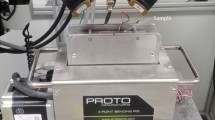Abstract
An electrical analog technique is described for determining stress intensity factors in the anti-plane shear loading. The experimental procedure consists of either determining electrical potential difference between the clamped ends of a metallic foil as a function of crack length under constant total current or determining the crack surface potential as a function of the crack length along the crack surface. Stress intensity factors have been determined for various crack (or specimen) geometries and are compared with theoretical expressions wherever available. The electrical method described here is extremely rapid and therefore offers an advantage over numerical methods.
Résumé
Une technique d'analogie électrique est décrite en vue de déterminer les facteurs d'intensité de contrainte dans le cas d'une mise en charge par cisaillement antiplanaire. La procédure expérimentale consiste soit à déterminer la différence de potentiel électrique entre les extrémités d'un feuillard métallique fixé, en fonction de la longueur de fissure sous courant total constant, soit à déterminer le potentiel de la surface de fissure en fonction de la longueur de la fissure le long de la surface fissurée. Des facteurs d'intensité de contrainte ont été déterminés pour diverses géométries de fissuration ou d'éprouvettes et ont été comparées avec des expressions théoriques disponibles. La méthode électrique décrite ici est extrêmement rapide et dès lors présente un avantage sur les méthodes numériques.
Similar content being viewed by others
References
P.J. Palmer and S.C. Redshaw,Aeronautical Quarterly 6 (1955) 13–30.
S.C. Redshaw and K.R. Rushton,Journal of the Mechanics and Physics of Solids 81 (1960) 173.
H. Liebmann,British Journal of Applied Physics 6 (1955) 145–157.
W.J. Barnett and A.R. Troiano,Transactions of the American Institute of Mining, Metallurgical and Petroleum Engineers 209 (1957) 486.
A.A. Anctil, E.B. Kula and E. Di Cesare,Proceedings of the American Society for Testing and Materials 63 (1963) 799.
R.O. Ritchie, G.G. Garrett and J.F. Knott,International Journal of Fracture Mechanics 7 (1971) RCR 462–467.
E.A. Steigerwald and G.L. Hanna,Proceedings of'the American Society for Testing and Materials 62 (1962) 885–913.
H.H. Johnson,Materials Research Standard 9 (1965) 442–45.
A.V. Virkar,Journal of the American Ceramic Society 63 [3–4] (1980) 219–223.
P.S. Theocaris, inDevelopments in Stress Analysis, ed. G. Hollister, 1, Chapter 2 (1974) 27.
G.C. Sih,Handbook of Stress Intensity Factors, Lehigh University Press, Bethlehem, Pa. (1973).
J.R. Rice,International Journal of Solids and Structures 8 (1972) 751–758.
Author information
Authors and Affiliations
Rights and permissions
About this article
Cite this article
Virkar, A.V. Application of electrical analog technique in fracture mechanics. Int J Fract 21, 15–30 (1983). https://doi.org/10.1007/BF01134196
Received:
Revised:
Issue Date:
DOI: https://doi.org/10.1007/BF01134196




